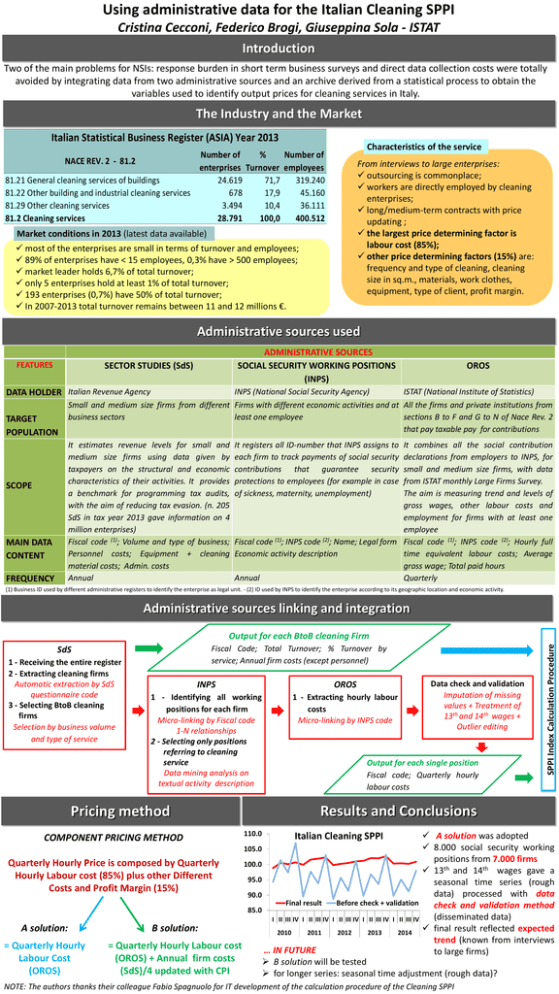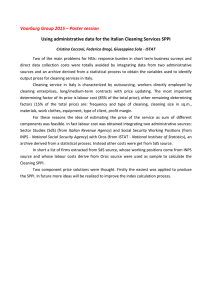Using administrative data for the Italian Cleaning SPPI
advertisement

Using administrative data for the Italian Cleaning SPPI Cristina Cecconi, Federico Brogi, Giuseppina Sola - ISTAT Introduction Two of the main problems for NSIs: response burden in short term business surveys and direct data collection costs were totally avoided by integrating data from two administrative sources and an archive derived from a statistical process to obtain the variables used to identify output prices for cleaning services in Italy. The Industry and the Market Characteristics of the service From interviews to large enterprises: outsourcing is commonplace; workers are directly employed by cleaning enterprises; long/medium-term contracts with price updating ; the largest price determining factor is labour cost (85%); other price determining factors (15%) are: frequency and type of cleaning, cleaning size in sq.m., materials, work clothes, equipment, type of client, profit margin. Market conditions in 2013 (latest data available) most of the enterprises are small in terms of turnover and employees; 89% of enterprises have < 15 employees, 0,3% have > 500 employees; market leader holds 6,7% of total turnover; only 5 enterprises hold at least 1% of total turnover; 193 enterprises (0,7%) have 50% of total turnover; In 2007-2013 total turnover remains between 11 and 12 millions €. Administrative sources used FEATURES ADMINISTRATIVE SOURCES SOCIAL SECURITY WORKING POSITIONS (INPS) SECTOR STUDIES (SdS) DATA HOLDER Italian Revenue Agency TARGET POPULATION SCOPE MAIN DATA CONTENT FREQUENCY INPS (National Social Security Agency) OROS ISTAT (National Institute of Statistics) Small and medium size firms from different Firms with different economic activities and at All the firms and private institutions from business sectors least one employee sections B to F and G to N of Nace Rev. 2 that pay taxable pay for contributions It estimates revenue levels for small and medium size firms using data given by taxpayers on the structural and economic characteristics of their activities. It provides a benchmark for programming tax audits, with the aim of reducing tax evasion. (n. 205 SdS in tax year 2013 gave information on 4 million enterprises) Fiscal code (1); Volume and type of business; Personnel costs; Equipment + cleaning material costs; Admin. costs Annual It registers all ID-number that INPS assigns to each firm to track payments of social security contributions that guarantee security protections to employees (for example in case of sickness, maternity, unemployment) It combines all the social contribution declarations from employers to INPS, for small and medium size firms, with data from ISTAT monthly Large Firms Survey. The aim is measuring trend and levels of gross wages, other labour costs and employment for firms with at least one employee Fiscal code (1); INPS code (2); Name; Legal form Fiscal code (1); INPS code (2); Hourly full Economic activity description time equivalent labour costs; Average gross wage; Total paid hours Annual Quarterly (1) Business ID used by different administrative registers to identify the enterprise as legal unit. - (2) ID used by INPS to identify the enterprise according to its geographic location and economic activity. Administrative sources linking and integration Fiscal Code; Total Turnover; % Turnover by service; Annual firm costs (except personnel) SdS 1 - Receiving the entire register 2 - Extracting cleaning firms Automatic extraction by SdS questionnaire code 3 - Selecting BtoB cleaning firms Selection by business volume and type of service INPS OROS 1 - Identifying all working positions for each firm Micro-linking by Fiscal code 1-N relationships 2 - Selecting only positions referring to cleaning service Data mining analysis on textual activity description 1 - Extracting hourly labour costs Micro-linking by INPS code Data check and validation Imputation of missing values + Treatment of 13th and 14th wages + Outlier editing Output for each single position Fiscal code; Quarterly hourly labour costs SPPI Index Calculation Procedure Output for each BtoB cleaning Firm Results and Conclusions Pricing method A solution was adopted 8.000 social security working 105.0 positions from 7.000 firms Quarterly Hourly Price is composed by Quarterly 100.0 13th and 14th wages gave a Hourly Labour cost (85%) plus other Different 95.0 seasonal time series (rough Costs and Profit Margin (15%) data) processed with data 90.0 Final result Before check + validation check and validation method 85.0 (disseminated data) I II III IV I II III IV I II III IV I II III IV I II III IV final result reflected expected A solution: B solution: 2010 2011 2012 2013 2014 trend (known from interviews = Quarterly Hourly = Quarterly Hourly Labour cost … IN FUTURE to large firms) Labour Cost (OROS) + Annual firm costs B solution will be tested (OROS) (SdS)/4 updated with CPI for longer series: seasonal time adjustment (rough data)? COMPONENT PRICING METHOD 110.0 Italian Cleaning SPPI NOTE: The authors thanks their colleague Fabio Spagnuolo for IT development of the calculation procedure of the Cleaning SPPI







